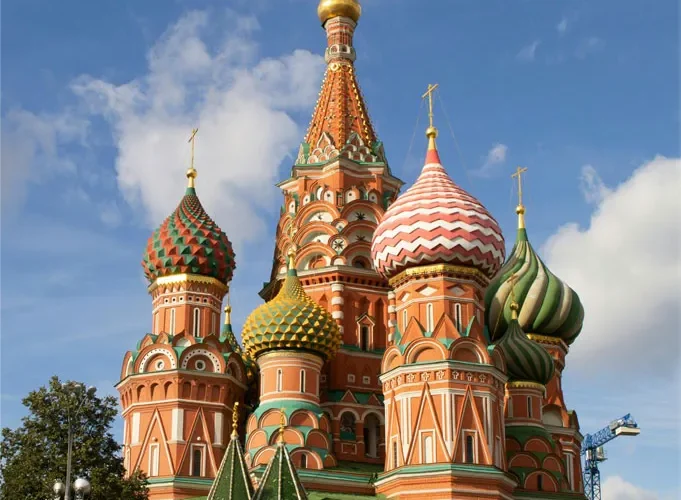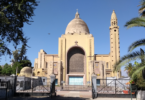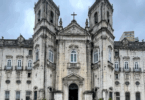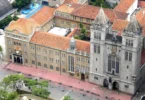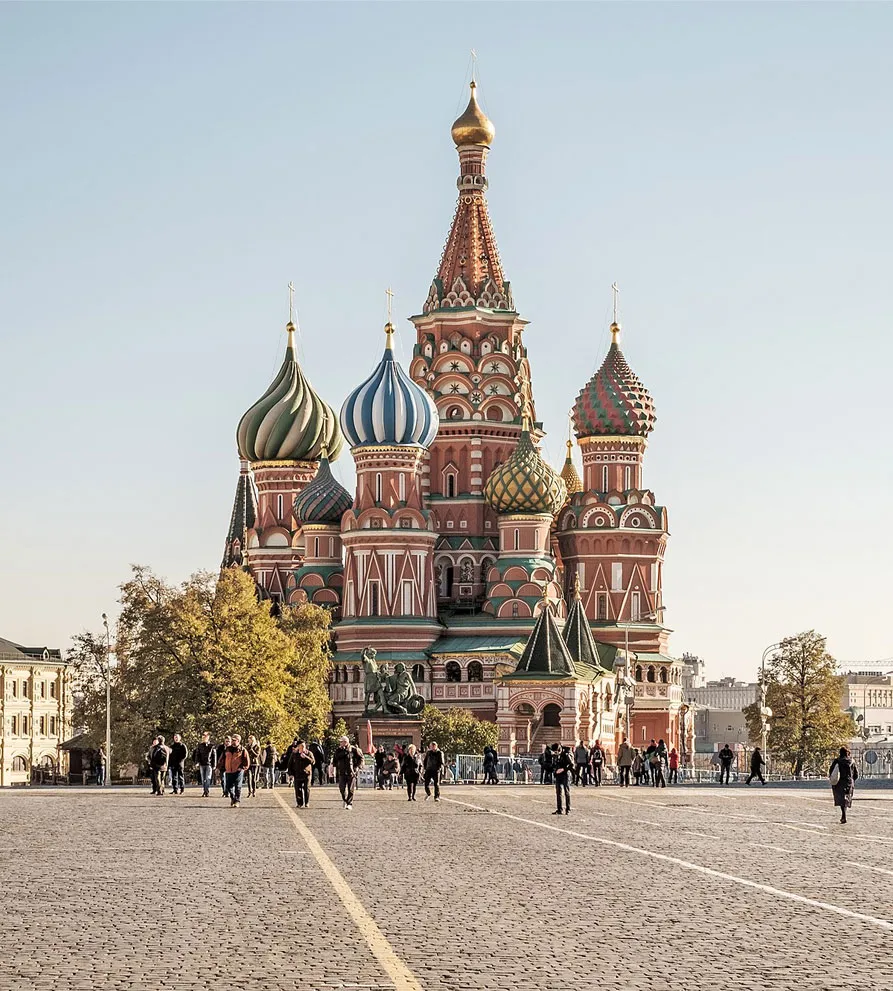
Introduction
St. Basil’s Cathedral is Moscow’s most famous artistic work of architecture. Also called “Pokrovsky Cathedral” or “The Cathedral of Intercession of the Virgin by the Moat”, it is the most recognizable Russian building. This Cathedral means to Russians the same as the Eiffel Tower to the French, being an honorable symbol of their past, present, and future. The Cathedral of Vasily the Blessed (Russian: Собор Василия Блаженного, romanized: Sobor Vasiliya Blazhennogo), known in English as Saint Basil’s Cathedral, is an Orthodox church in Red Square of Moscow, and is one of the most popular cultural symbols of Russia. The building, now a museum, is officially known as the Cathedral of the Intercession of the Most Holy Theotokos on the Moat, or Pokrovsky Cathedral. It was built from 1555 to 1561 on orders from Ivan the Terrible and commemorates the capture of Kazan and Astrakhan. Its completion, with its colors, was made in 1683. It was the city’s tallest building until the completion of the Ivan the Great Bell Tower in 1600.
The original building, known as Trinity Church and later Trinity Cathedral, contained eight chapels arranged around a ninth, central chapel dedicated to the Intercession; a tenth chapel was erected in 1588 over the grave of the venerated local saint Vasily (Basil). In the 16th and 17th centuries, because it was perceived as the earthly symbol of the Heavenly City. Like all churches in Byzantine Christianity, the church was popularly known as the “Jerusalem” and served as an allegory of the Jerusalem Temple in the annual Palm Sunday parade attended by the Patriarch of Moscow and the Tsar.
The cathedral has nine domes (each one corresponding to a different church) and is shaped like the flame of a bonfire rising into the sky. Dmitry Shvidkovsky, in his book Russian Architecture and the West, states that “it is like no other Russian building. Nothing similar can be found in the entire millennium of Byzantine tradition from the fifth to the fifteenth century … a strangeness that astonishes by its unexpectedness, complexity and dazzling interleaving of the manifold details of its design. “The cathedral foreshadowed the climax of Russian national architecture in the 17th century.
As part of the program of state atheism, the church was confiscated from the Russian Orthodox community as part of the Soviet Union’s antireligious campaigns and has operated as a division of the State Historical Museum since 1928. It was completely secularized in 1929, and remains a federal property of the Russian Federation. The church has been part of the Moscow Kremlin and Red Square UNESCO World Heritage Site since 1990. With the dissolution of the Soviet Union in 1991, weekly Orthodox Christian services with prayer to St. Basil have been restored since 1997.
The Cathedral of the Intercession of the Virgin on the Moat is better known as the Cathedral of Saint Basil the Blessed: St Basil’s Cathedral. It is the most recognizable church in Russia. St Basil’s Cathedral was built in the 16th century by the order of Ivan the Terrible. Since then, it has fascinated travelers coming to Moscow. Some found it bizarre; its unusual beauty entranced others.
The church is shrouded in legends and myths. People say that the cruel Russian tsar had the architect blinded to prevent him from building a more magnificent building for anyone else. Legend has it that Napoleon wanted to destroy the Cathedral when he realized he couldn’t relocate it to Paris. The Cathedral was commissioned by Ivan the Terrible to commemorate the capture of the Khanate of Kazan. It was constructed from 1555 to 1561.
Saint Basil’s is a cluster of buildings – a central church surrounded by nine auxiliary churches, eight dedicated to Ivan’s eight victories over the Tatars, and a smaller one consecrated to Saint Basil. This famous Moscow saint was buried in the grounds, and his name later became the name of the Cathedral. According to chronicles from the time, St Basil’s Cathedral was designed by two Russian architects: Barma and Postnik. Another theory suggests that Yakovlev and Barma were one person. Many serious Russian historians believe that architects were not blinded and went to construct more churches in Russia.
The third version says that the temple was erected under the guidance of an architect from Western Europe. The unusual composition of St. Basil’s Cathedral and a blend of Russian and Western European elements of decoration prove that there was a distinctive influence from abroad. The last version, however, has no proof in chronicles. St Basil’s Cathedral on Red Square remains the most unusual church in Russia and has become an enigmatic symbol of Moscow itself, surviving the Revolution and Soviet times. Saint Basil’s Cathedral in Moscow is a proud survivor of the city’s tumultuous history. Rising majestically from Red Square, it provides a striking contrast to the monochrome buildings characteristic of the Soviet era that fill much of the city. It has remained standing despite several fires, Napoleon’s invasion and the demolition of churches like the Cathedral of Christ the Saviour under Stalin.
At the southern end of Red Square stands the icon of Russia: St Basil’s Cathedral. This crazy confusion of colours, patterns and shapes is the culmination of a style that is unique to Russian architecture. In 1552 Ivan the Terrible captured the Tatar stronghold of Kazan on the Feast of Intercession. He commissioned this landmark church, officially the Intercession Cathedral, to commemorate the victory. Created from 1555 to 1561, this masterpiece would become the ultimate symbol of Russia.
The cathedral’s apparent anarchy of shapes hides a comprehensible plan of nine main chapels. The tall, tent-roofed tower in the centre houses the namesake Church of the Intercession of the Mother of God. The four biggest domes top four octagonal-towered chapels: the Church of Sts Cyprian & Justina, Church of the Holy Trinity, Church of the Icon of St Nicholas the Miracle Worker, and the Church of the Entry of the Lord into Jerusalem. Finally, there are four smaller chapels in between. Each chapel was consecrated in honour of an event or battle in the struggle against Kazan.
Legend has it that Ivan had the architects blinded so that they could never build anything comparable. This is a myth, however, as records show that they were employed a quarter of a century later (and four years after Ivan’s death) to add an additional chapel to the structure.
The Church of St Vasily the Blessed, the northeastern chapel on the 1st floor, contains the canopy-covered crypt of its namesake saint, one of the most revered in Moscow. Vasily (Basil) the Blessed was known as a ‘holy fool’, sometimes going naked and purposefully humiliating himself for the greater glory of God. He was believed to be a seer and miracle maker, and even Ivan the Terrible revered and feared him. This 10th chapel – the only one at ground level – was added in 1588, after the saint’s death. Look for the icon depicting St Vasily himself, with Red Square and the Kremlin in the background.
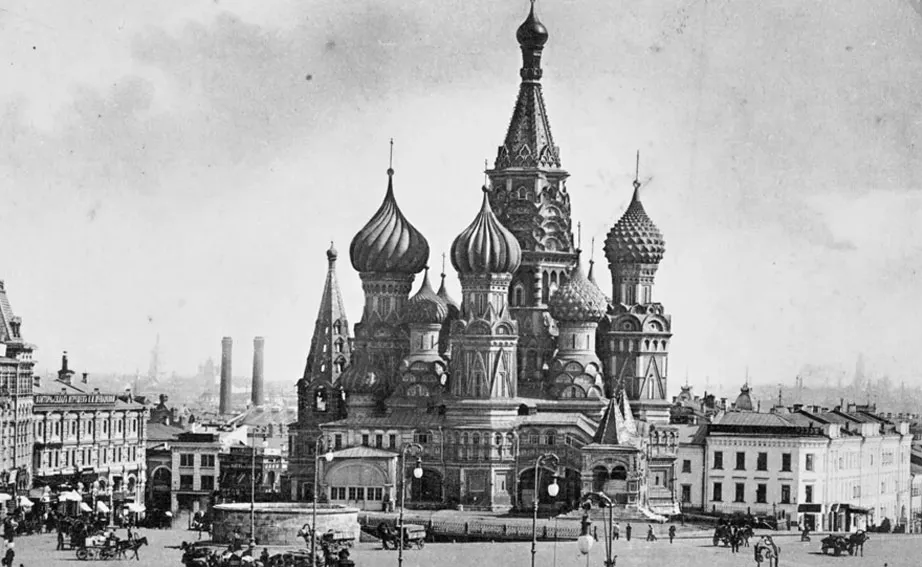
The site of the church had been, historically, a busy marketplace between the St. Frol’s (later Saviour’s) Gate of the Moscow Kremlin and the outlying posad. The centre of the marketplace was marked by the Trinity Church, built of the same white stone as the Kremlin of Dmitry Donskoy (1366-68) and its cathedrals. Tsar Ivan IV marked every victory of the Russo-Kazan War by erecting a wooden memorial church next to the walls of Trinity Church; by the end of his Astrakhan campaign, it was shrouded within a cluster of seven wooden churches. According to the sketchy report in Nikon’s Chronicle, in the autumn of 1554 Ivan ordered construction of the wooden Church of Intercession on the same site, “on the moat”. One year later, Ivan ordered construction of a new stone cathedral on the site of Trinity Church that would commemorate his campaigns. Dedication of a church to a military victory was “a major innovation” for Muscovy. The placement of the church outside of the Kremlin walls was a political statement in favour of posad commoners and against hereditary boyars.
Chronists clearly identified the new building as Trinity Church, after its easternmost sanctuary; the status of “sobor” (large assembly church) has not been bestowed on it yet: In the same year, through the will of czar and lord and grand prince Ivan began making the pledged church, as he promised for the capture of Kazan: Trinity and Intercession and seven sanctuaries, also called “on the moat”. And the builder was Barma with company.
The identity of the architect is unknown. Tradition held that the church was built by two architects, Barma and Postnik: the official Russian cultural heritage register lists “Barma and Postnik Yakovlev”. Researchers proposed that both names refer to the same person, Postnik Yakovlev or, alternatively, Ivan Yakovlevich Barma (Varfolomey). Legend held that Ivan blinded the architect so that he could not re-create the masterpiece elsewhere, although the real Postnik Yakovlev remained active at least throughout the 1560s. There is evidence that construction involved stonemasons from Pskov and German lands.
Architecture of St. Basil's Cathedral
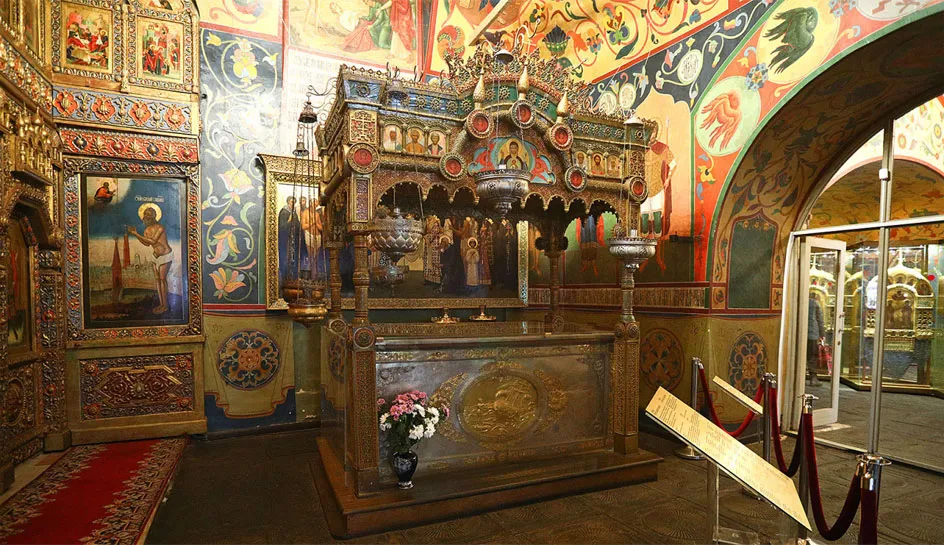
Architectural style: Tented-roof church
Architects: Postnik Yakovlev, Ivan Barma
St. Basil’s was built from 1555 to 1561. Architectural historians often credit Ivan Barma and Postnik Yakovlev as the architects and builders of this famed church. However, one legend stipulates that Italian architects designed the cathedral, and the wrathful Tsar Ivan IV blinded them so that they could not replicate the design.
St Basil’s Cathedral is one of the most unusual Russian churches. A visiting 19th-century French aristocrat, the Marquis de Custine, compared the cathedral to “the scales of a golden fish, the enameled skin of a serpent, the changeful hues of the lizard, the glossy rose and azure of the pigeon’s neck.” He wondered whether “the men who go to worship God in this box of confectionery work.” could be a Christian. The height of St. Basil’s Cathedral is 65 meters. For a long time, until the end of the 16th century, it was the tallest building in Moscow. Nine independent temples are built on a single foundation – and are interconnected by internal vaulted passages decorated with ornaments in the form of herbs and flowers. The building is devoid of a clearly expressed facade. Whichever side you approach the cathedral – it seems that it is the main one.
The cathedral is built of bricks. In the 16th century, this material was relatively new: before, churches’ traditional materials was limestone. No matter how complex the structure of the temple may seem, it is very logical. The center of the composition is the main tent-roofed Church of the Intercession, around which there are eight other pillar-like domed churches. In plan, the cathedral forms an eight-pointed star. The eight-pointed star in Christian symbolism carries a deep meaning – it symbolizes the entire Christian church, which is a guiding star in a person’s life to Heavenly Jerusalem.
Exterior
St Basil’s Cathedral boasts a design unparalleled anywhere else in Russia, indicating the brilliant talent of its creators who dared to break the traditional canons of religious architecture. Its nine towers are crowned with candy-coloured onion domes exuding festivity and cheerfulness. Each tower is embellished with layers ofcornices, kokoshniks, and windows; floral motifs snake up the porches, stairs and galleries; and geometric tiles and patterns punctuate the brickwork.Originally, St Basil’s Cathedral was not the riot of colour that we see today, but had an austere red and white façade. In the 17th and 18th centuries, successive emperors and empresses significantly modified the cathedral’s appearance. Brick porches and galleries were added, multicoloured paintwork and tiles brightened the façade, and the ornamental domes attained their vibrant colours and design.
Interior
St Basil’s is uniquely fascinating for the variety ofarchitectural and artistic styles present in its interior. The wonders to be discovered inside the cathedral include: oil paintings, frescoes, portraits, and landscape painting; iconostases comprising over 400 masterpieces of Moscow and Novgorod iconography from the 16th-19th centuries; and valuable exhibits belonging to the church and imperial family. The cathedral’s chapels are connected via a labyrinth of vaulted internal passages and galleries, which are adorned from floor to ceiling with colourful geometric designs and natural motifs.
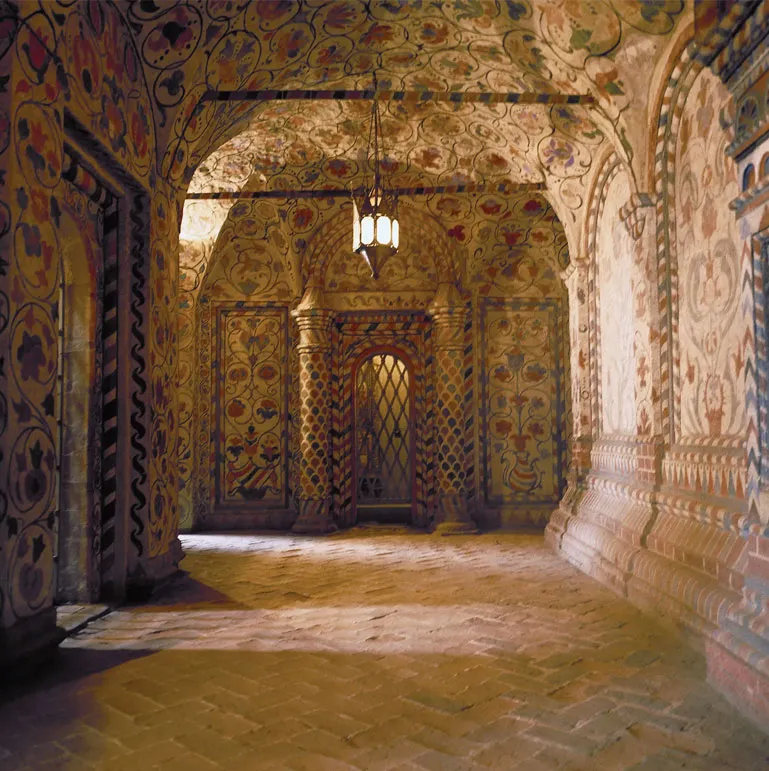
Architecture Style of St. Basil's Cathedral
Because the church has no analog—in the preceding, contemporary, or later architecture of Muscovy and Byzantine cultural tradition, in general,—the sources that inspired Barma and Postnik are disputed. Eugène Viollet-le-Duc rejected European roots for the cathedral, opining that its corbel arches were Byzantine and ultimately Asian.A modern “Asian” hypothesis considers the cathedral a recreation of Qolşärif Mosque, which was destroyed by Russian troops after the Siege of Kazan.
Nineteenth-century Russian writers, starting with Ivan Zabelin, emphasized the influence of the vernacular wooden churches of the Russian North; their motifs made their ways into masonry, particularly the votive churches that did not need to house substantial congregations. David Watkin also wrote of a blend of Russian and Byzantine roots, calling the cathedral “the climax” of Russian vernacular wooden architecture.
The church combines the staggered layered design of the earliest (1505–1508) part of the Ivan the Great Bell Tower,the central tent of the Church of Ascension in Kolomenskoye (1530s), and the cylindric shape of the Church of Beheading of John the Baptist in Dyakovo (1547); but the origin of these unique buildings is equally debated. The Church in Kolomenskoye, according to Sergei Podyapolsky, was built by Italian Petrok Maly, although mainstream history has not yet accepted his opinion. Andrey Batalov revised the year of completion of Dyakovo church from 1547 to the 1560s–70s, and noted that Trinity Church could have had no tangible predecessors at all. Dmitry Shvidkovsky suggested that the “improbable” shapes of the Intercession Church and the Church of Ascension in Kolomenskoye manifested an emerging national renaissance, blending earlier Muscovite elements with the influence of Italian Renaissance. A large group of Italian architects and craftsmen continuously worked in Moscow in 1474–1539, as well as Greek refugees who arrived in the city after the fall of Constantinople. These two groups, according to Shvidkovsky, helped Moscow rulers in forging the doctrine of Third Rome, which in turn promoted assimilation of contemporary Greek and Italian culture.Shvidkovsky noted the resemblance of the cathedral’s floorplan to Italian concepts by Antonio da Sangallo the Younger and Donato Bramante, but most likely Filarete’s Trattato di architettura. Other Russian researchers noted a resemblance to sketches by Leonardo da Vinci, although he could not have been known in Ivan’s Moscow.Nikolay Brunov recognized the influence of these prototypes but not their significance; he suggested that mid-16th century Moscow already had local architects trained in Italian tradition, architectural drawing and perspective, and that this culture was lost during the Time of Troubles.
Andrey Batalov wrote that judging by the number of novel elements introduced with Trinity Church, it was most likely built by German craftsmen.Batalov and Shvidkovsky noted that during Ivan’s reign, Germans and Englishmen replaced Italians, although German influence peaked later during the reign of Mikhail Romanov. German influence is indirectly supported by the rusticated pilasters of the central church, a feature more common in contemporary Northern Europe than in Italy.
The 1983 academic edition of Monuments of Architecture in Moscow takes the middle ground: the church is, most likely, a product of the complex interaction of distinct Russian traditions of wooden and stone architecture, with some elements borrowed from the works of Italians in Moscow.Specifically, the style of brickwork in the vaults is Italian.
Layout
Instead of following the original ad hoc layout (seven churches around the central core), Ivan’s architects opted for a more symmetrical floor plan with eight side churches around the core, producing “a thoroughly coherent, logical plan” despite the erroneous latter “notion of a structure devoid of restraint or reason” influenced by the memory of Ivan’s irrational atrocities. The central core and the four larger churches placed on the four major compass points are octagonal; the four diagonally placed smaller churches are cuboid, although their shape is hardly visible through later additions. The larger churches stand on massive foundations, while the smaller ones were each placed on a raised platform as if hovering above ground.
Although the side churches are arranged in perfect symmetry, the cathedral as a whole is not. The larger central church was deliberately offset to the west from the geometric centre of the side churches, to accommodate its larger apse on the eastern side. As a result of this subtle calculated asymmetry, viewing from the north and the south presents a complex multi-axial shape, while the western façade, facing the Kremlin, appears properly symmetrical and monolithic. The latter perception is reinforced by the fortress-style machicolation and corbeled cornice of the western Church of Entry into Jerusalem, mirroring the real fortifications of the Kremlin. Inside the composite church is a labyrinth of narrow vaulted corridors and vertical cylinders of the churches. Today the cathedral consists of nine individual chapels. The largest, central one, the Church of the Intercession, is 46 metres (151 ft) tall internally but has a floor area of only 64 square metres (690 sq ft). Nevertheless, it is wider and airier than the church in Kolomenskoye with its exceptionally thick walls. The corridors functioned as internal parvises; the western corridor, adorned with a unique flat caissoned ceiling, doubled as the narthex.
The detached belfry of the original Trinity Church stood southwest or south of the main structure. Late 16th- and early 17th-century plans depict a simple structure with three roof tents, most likely covered with sheet metal. No buildings of this type survive to date, although it was then common and used in all of the pass-through towers of Skorodom. August von Meyenberg’s panorama (1661) presents a different building, with a cluster of small onion domes.
Structure
The foundations, as was traditional in medieval Moscow, were built of white stone, while the churches themselves were built of red brick (28 by 14 by 8 cm (11.0 by 5.5 by 3.1 in)), then a relatively new material (the first attested brick building in Moscow, the new Kremlin Wall, was started in 1485). Surveys of the structure show that the basement level is perfectly aligned, indicating use of professional drawing and measurement, but each subsequent level becomes less and less regular. Restorers who replaced parts of the brickwork in 1954–1955 discovered that the massive brick walls conceal an internal wooden frame running the entire height of the church.This frame, made of elaborately tied thin studs, was erected as a life-size spatial model of the future cathedral and was then gradually enclosed in solid masonry.
The builders, fascinated by the flexibility of the new technology, used red bricks as a decorative medium both inside and out, leaving as much brickwork open as possible; when location required the use of stone walls, it was decorated with a brickwork pattern painted over stucco. A major novelty introduced by the church was the use of strictly “architectural” means of exterior decoration. Sculpture and sacred symbols employed by earlier Russian architecture are completely missing; floral ornaments are a later addition. Instead, the church boasts a diversity of three-dimensional architectural elements executed in brick.
The Mystery of Colors
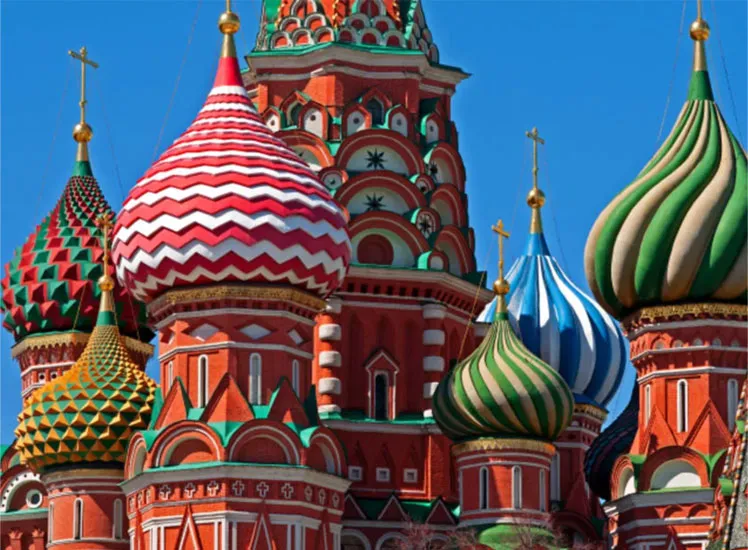
The church in the 16th century looked different from today. The vivid multicolored pattern on its domes appeared only in the 17th – early 18th century. Original Cathedral was painted mostly red and white. Numerous art historians believe that The Cathedral of St. Basil the Blessed was built as a visual representation of the Heavenly Jerusalem. It was meant to symbolize both a town and heaven in the middle of Moscow. How to depict the Heavenly city? Does it need to resemble Jerusalem? Should it look like the Kremlin? The epochs changed, along with them, the people’s idea of how paradise should look. The church acquired its vivid present-day colors more than 100 years after its construction. The bright pattern of the church domes makes it look like a blossoming garden of heaven.
Colors
The church acquired its present-day vivid colours in several stages from the 1680s to 1848. Russian attitude towards colour in the 17th century changed in favour of bright colours; iconographic and mural art experienced an explosive growth in the number of available paints, dyes and their combinations. The original colour scheme, missing these innovations, was far less challenging. It followed the depiction of the Heavenly City in the Book of Revelation. And he that sat was to look upon like a jasper and a sardine stone: and there was a rainbow round about the throne, in sight like unto an emerald. And round about the throne were four and twenty seats: and upon the seats, I saw four and twenty elders sitting, clothed in white raiment; and they had on their heads crowns of gold.
The 25 seats from the biblical reference are alluded to in the building’s structure, with the addition of eight small onion domes around the central tent, four around the western side church and four elsewhere. This arrangement survived through most of the 17th century. The walls of the church mixed bare red brickwork or painted imitation of bricks with white ornaments, in roughly equal proportion. The domes, covered with tin, were uniformly gilded, creating an overall bright but fairly traditional combination of white, red and golden colours. Moderate use of green and blue ceramic inserts provided a touch of rainbow as prescribed by the Bible. While historians agree on the colour of the 16th-century domes, their shape is disputed. Boris Eding wrote that they most likely were of the same onion shape as the present-day domes. However, both Kolomenskoye and Dyakovo churches have flattened hemispherical domes, and the same type could have been used by Barma and Postnik.
St Basil's Cathedral Inside
The cathedral is not very spacious but intimate and atmospheric inside. You can follow a maze of darkened galleries from one chapel to the next, experiencing the building’s medieval past.
- These days the church is a museum. What are the top reasons to go inside?
- Find the shrine of St Basil and learn the story of the Russian holy fools.
- Take photos of the church interior. In most Russian churches, photography is not allowed.
- Discover the hiding places in the walls were treasures were kept in the past
- Learn the secrets of the Russian church acoustics
- A true gem of your visit will be the church male choir singing in one of the chapels.

Allegory of Jerusalem
Construction of wrap-around ground-floor arcades in the 1680s visually united the nine churches of the original cathedral into a single building. Earlier, the clergy and the public perceived it as nine distinct churches on a common base, a generalized allegory of the Orthodox Heavenly City similar to fantastic cities of medieval miniatures. At a distance, separate churches towering over their base resembled the towers and churches of a distant citadel rising above the defensive wall. The abstract allegory was reinforced by real-life religious rituals where the church played the role of the biblical Temple in Jerusalem:
The capital city, Moscow, is split into three parts; the first of them, called Kitai-gorod, is encircled with a solid thick wall. It contains an extraordinary beautiful church, all clad in shiny bright gems, called Jerusalem. It is the destination of an annual Palm Sunday walk, when the Grand Prince must lead a donkey carrying the Patriarch, from the Church of Virgin Mary to the church of Jerusalem which stands next to the citadel walls. Here is where the most illustrious princely, noble and merchant families live. Here is, also, the main muscovite marketplace: the trading square is built as a brick rectangle, with twenty lanes on each side where the merchants have their shops and cellars. Templum S. Trinitatis, etiam Hierusalem dicitur; ad quo Palmarum fest Patriarcha asino insidens a Caesare introducitur. Temple of Holy Trinity, also called Jerusalem, to where the tsar leads the Patriarch, sitting on a donkey, on the Palm Holiday.
The last donkey walk (хождение на осляти) took place in 1693. Mikhail Petrovich Kudryavtsev [ru] noted that all cross processions of the period began, as described by Petreius, from the Dormition Church, passed through St. Frol’s (Saviour’s) Gate and ended at Trinity Cathedral. For these processions the Kremlin itself became an open-air temple, properly oriented from its “narthex” (Cathedral Square) in the west, through the “royal doors” (Saviour’s Gate), to the “sanctuary” (Trinity Cathedral) in the east.
Naming
The building, originally known as “Trinity Church”, was consecrated on 12 July 1561, and was subsequently elevated to the status of a sobor (similar to an ecclesiastical basilica in the Catholic Church, but usually and incorrectly translated as “cathedral”). “Trinity”, according to tradition, refers to the easternmost sanctuary of the Holy Trinity, while the central sanctuary of the church is dedicated to the Intercession of Mary. Together with the westernmost sanctuary of the Entry into Jerusalem, these sanctuaries form the main east–west axis (Christ, Mary, Holy Trinity), while other sanctuaries are dedicated to individual saints. The name “Intercession Church” came into use later, coexisting with Trinity Church. From the end of the 16th century to the end of the 17th century the cathedral was also popularly called Jerusalem, with reference to its church of Entry into Jerusalem as well as to its sacral role in religious rituals. Finally, the name of Vasily (Basil) the Blessed, who died during construction and was buried on-site, was attached to the church at the beginning of the 17th century.
Current Russian tradition accepts two coexisting names of the church: the official”Church of Intercession on the Moat” (in full, the “Church of Intercession of Most Holy Theotokos on the Moat”), and the “Temple of Basil the Blessed”. When these names are listed together the latter name, being informal, is always mentioned second. The common Western translations “Cathedral of Basil the Blessed” and “Saint Basil’s Cathedral” incorrectly bestow the status of cathedral on the church of Basil, but are nevertheless widely used even in academic literature. Especially during the 19. century, in English and other languages the Saint Basil’s Cathedral was also called (Cathedral or Church of) Vassili Blagennoi.
One of Moscow's Most Precious Treasures
A UNESCO World Heritage Site and internationally recognised symbol of Russia, St Basil’s is one of Moscow’s most spectacular monuments, a magnificent landmark that has been present for almost 500 years of the city’s history. During your trip to Moscow, you’re bound to pass by the cathedral on numerous occasions: it’s definitely worth seeing both in the day, to fully admire its vivid rainbow of colours, and at night, to see the lovely illuminations after dark. While it is one of of the capital’s must-see monuments, if you’re short on time or have a tight budget, just stick to seeing the outside. It’s often common to confuse the cathedral as part of the Kremlin, which is located just next door, but they are completely separate. As well as the Kremlin, St Basil’s central location means you can combine it with a visit to Lenin’s Mausoleum, the GUM or the Moscow’s State Historical Museum.
Church of the Intercession of the Holy Virgin
St Basil’s central chapel, from which the cathedral takes its official name. You can discover the true scale of the cathedral from inside the central church. In some places the original brickwork and painting has been preserved, including an inscription bearing the date of completion of St Basil’s Cathedral (12th July 1561), illuminated by a magnificent chandelier. The huge Baroque-style iconostasis was brought to Moscow in the late 1700s.
Church of St Gregory of Armenia
One of St Basil’s four small chapels, consecrated in honour of Saint Gregory, who was responsible for converting Armenia to Christianity. The demolition of the Arsk tower of Kazan’s fortress in 1552, a key moment in Ivan’s campaign, fell on the saint’s day (30th September). Austere whitewashed walls are offset with a vibrant iconostasis draped with silk and velvet curtains. Also visible are architectural features of the 16th century, religious garments from the 17th century, traditional candles, and an elegant enamel lamp. A grid of yellow diamonds embellishes the exterior dome.
Church of Saint Vasily (Saint Basil)
The smallest chapel in the ensemble, but perhaps the most richly decorated, with bright murals portraying religious figures and scenes from the life of Saint Vasily. The construction of the iconostasis was overseen by famous artist Osip Chirikov. It is so large that it stretches along the adjacent walls, and its icons are set into a background of gold, red and blue; two ancient icons are particularly notable: Our Lady of Smolensk and The Image of Saint Vasily the Blessed. The canopy above Saint Vasily’s resting placeis one of the most revered shrines in Moscow.
Bell Tower
Added to the cathedral’s ensemble in the late 1600s, and slightly detached from the main structure. It is topped with a steep octagonal tent lined with small windows and multicoloured tiles. On the southern wall of the bell tower is an enormous and famous icon, The Veil with Basil and John the Blessed. There are several themed and general excursions available to book at St Basil’s Cathedral, but for an enjoyable and informative day out, why not take Express to Russia’s private Moscow tour, which includes a visit to this magnificent monument.
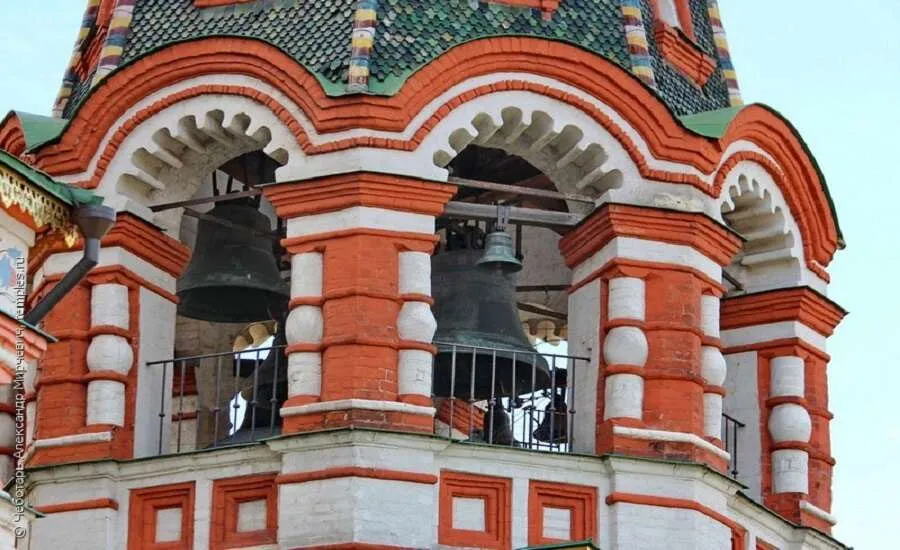
St. Basil’s Cathedral during Soviet Russia
The Soviets recognised St Basil’s Cathedral as significant and irreplaceable national monument. It wasdecided to maintain and restore the cathedral, and transform it into a museum with exhibitions about architecture, history, politics, and religion. St Basil’s opened to the public in May 1923, and in 1928, became a branch of the State History Museum, where it has remained ever since. Red Square was used for enormous parades and demonstrations, and under Stalin, various historical buildings were flattened to maximise space there. One of Stalin’s closest associates, Lazar Kaganovich, suggested demolishing St Basil’s Cathedral-Kaganovich had already overseen the destruction of Christ the Saviour Cathedral and the Kremlin’s Kazan Cathedral. However, architect Pyotr Baranovsky begged the Politburo to leave the cathedral untouched, and even sent a telegram to Stalin himself. Baranovsky is credited with saving St Basil’s.
Renovations and Changes to St. Basil's Cathedral
In the late 1600s, St. Basil’s Cathedral underwent a renovation and expansion project. From 1680 to 1683, a new, two-story brick annex was added to the cathedral’s eastern side, creating additional space for the priests and the congregation. The annex features an ornate exterior with decorative arches and highly intricate carvings.
Religious and Cultural Importance
St. Basil’s Cathedral has a rich religious history, and it has served as a prominent site for Orthodox Christian services for centuries. During the Soviet era, however, the church was no longer permitted to hold services, as the Communist regime imposed strict restrictions on all religious practices. The church was not restored as a place of worship until after the dissolution of the Soviet Union in 1991. Today, it continues to hold religious services for Russian Orthodox Christians.
Red Square Moscow, Russia
Red Square, open square in Moscow adjoining the historic fortress and centre of government known as the Kremlin (Russian: Kreml). The Kremlin and Red Square were added to UNESCO’s World Heritage List in 1990. Dating from the late 15th century, just after the Kremlin walls were completed, Red Square has long been a focal point in the social and political history of Russia and the former Soviet Union. It has had several names, but the present name has been used consistently since the later 17th century. Always a market area, the square has also housed, at various times, churches, Moscow’s first public library and university, a public theatre, and a printing house.
Red Square has been the scene of executions, demonstrations, riots, parades, and speeches. Almost 800,000 square feet (73,000 square metres), it lies directly east of the Kremlin and north of the Moskva River. A moat that separated the square from the Kremlin was paved over in 1812. The State Historical Museum (built 1875–83) stands at the northern end of the square. Directly opposite, at its southern end, is the nine-towered Cathedral of St. Basil the Blessed (originally Church of the Intercession), built 1554–60 to commemorate the defeat of the Tatars (Mongols) of Kazan and Astrakhan by Ivan IV (the Terrible). Nearby is a white stone platform (Lobnoye Mesto) dating from the 16th century. From there, edicts and decrees were read to the assembled masses, and once a year the tsar would present himself to the people. GUM, the former State Department Store (built 1889–93; privatized 1993), is on the east side, and Lenin’s tomb, designed by Alexei Shchusev and completed in 1930, is on the west. Other graves near Lenin’s tomb flank the spruce-lined Kremlin wall.
In 1930 the cobblestone paving of Red Square was replaced with granite paving stones, and a monument to Kuzma Minin and Prince Dmitry Pozharsky (leaders of the army that forced the surrender of Polish invaders in 1612) was moved from the centre of the square to its present location in front of St. Basil’s in order to facilitate parades and demonstrations. During the Soviet era the annual May Day and October Revolution (November 7 Day) military parades were probably the best-known celebrations held in Red Square. Although they were discontinued after the collapse of the Soviet Union in 1991, they were revived in 2008 by Pres. Vladimir Putin.
St. Basil’s Cathedral today
St Basil’s Cathedral was designated a UNESCO World Heritage Site in 1990. Church services resumed in 1991 and work began to finally bring the cathedral’s bells back to life – today, the bell tower is home to 19 bells ranging from 25 to nearly 500 years old! In 2007, the St Basil’s was declared to be one of the Seven Wonders of Russia. Today, St Basil’s Cathedral bustles with spiritual and secular activity. Aside from its chapels and church services, the cathedral is also home to festivals, exhibitions, artistic events, concerts, and so much more.
Exterior: St Basil’s architecture is unique throughout the whole of Russia. Its nine church towers are crowned with candy-coloured onion domes, and embellished with layers of cornices, kokoshniks, windows, colourful tiles and patterns.
Interior: St Basil’s ensemble comprises eleven churches, each with unique architecture and artistic decoration and consecrated in honour of significant events in Russia’s political and spiritual history. Visitors can discover marvellous artwork, magnificent iconostases housing hundreds of masterful icons, and valuable exhibits belonging to the church and imperial family.
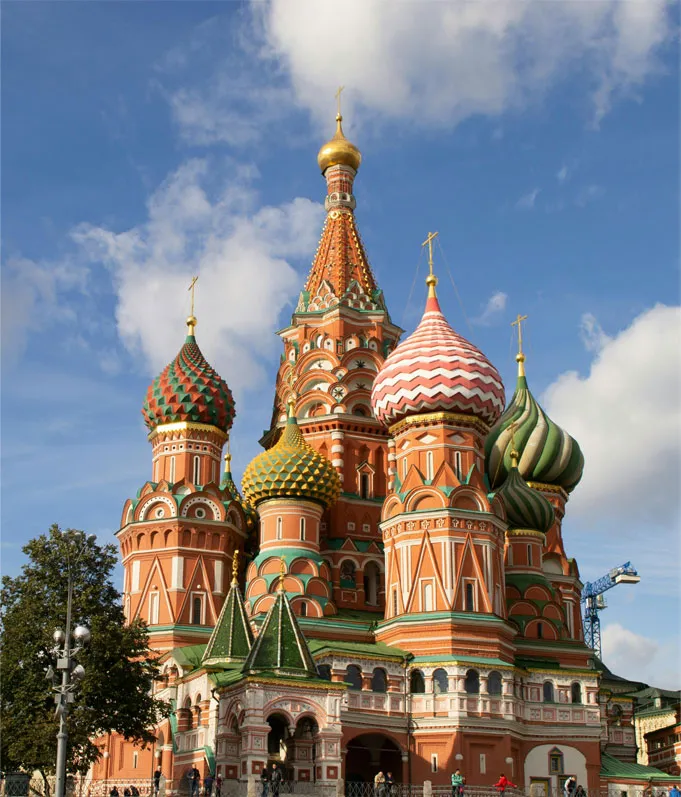
Annual Feast Day
Feast day: 02 August
The annual feast day of The Church of St. basil’s Cathedral Moscow, Russia is celebrated on August 02 each year.
Mass Timing
Mon – Sun: 10:00–21:00
June – August: 10 a.m. – 6 p.m.
September, October, May: 11 a.m. – 6 p.m.
November – April: 11 a.m. – 5 p.m.
Closed on the first Wednesday of each month
Contact Info
St. Basil’s Cathedral ,
Red Square,
7, Moscow,
Russia,
109012
Phone No.
Phone: +7 495 698-33-04
Accommodations
Connectivities
Airway
St. basil’s Cathedral (Pokrovsky Cathedral) Moscow, Russia, to Bol’shaya Sukharevskaya Ploshchad, distance 14 min ( 8.6 km )via Garden Ring.
Railway
St. basil’s Cathedral (Pokrovsky Cathedral) Moscow, Russia, to Leningradsky Railway Station, distance between 24 min ( 10.6 km )via Garden Ring.

